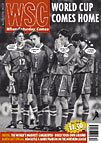 Neil McCarthy explains why Arsenal's attempt to buy a teenager from Paris St Germain has incurred the wrath of the French football authorities
Neil McCarthy explains why Arsenal's attempt to buy a teenager from Paris St Germain has incurred the wrath of the French football authorities
On the eve of Paris Saint Germain’s Super Cup match against Juventus, PSG announced that Arsène Wenger was attempting to “poach” one of their youth players, the 17-year-old Nicolas Anelka. The televizing of the Super Cup match was an excellent opportunity for eminent figures in French football such as Michel Platini and Noël Le Graët to denounce Arsenal’s move and, as PSG certainly hoped, the affair has become a major issue.
Whether Anelka plays for Arsenal next season is no longer just a question of whether a particular player can sign for a foreign club at the end of the season, but has become for many a central issue in the future of league football in France.To understand this reaction you have to go back to Euro 96 when it became apparent that many of the national team’s “heroes” would not be on show in French grounds the following season. Indeed, of the 22 player squad taken to England in June, only 8 now play for French clubs (and three of them are goalkeepers).
At the start of 1996-97 French football chiefs placed their hopes firmly on the shoulders of the exciting new talent, rising to take the place of the foreign exports in first team squads. This with the promise that the next Zidane or Djorkaeff would develop in a league with clubs capable of competing financially with foreign rivals thanks to new television and merchandising deals.
The Anelka incident, though, proves that this master plan for making France a first-class footballing nation may have a serious flaw. Because the real fear is not that France may lose Nicolas Anelka to Arsenal, but that Arsène Wenger has revealed a loop-hole in France’s “Football Charter” that means any European club can effectively help themselves to France’s best young players.
The Charter dates from the 1970’s and controls among other things the rules for the transfer of players. It also details a national youth training programme that regulates the different stages through which a player passes from signing for a club at 16 through to them becoming a professional player for that club.
Anelka is on an aspirant (cadet) contract – one up from an apprenti (apprentice) and one down from a stagaire (trainee). Despite having several first team appearances under his belt, he is paid only 3,800F (£475) a month, as are all other players on similar contracts at other top French clubs, some of whom are regular first team players.
Anelka’s contract expires in June 1997, at which time PSG have the option of either releasing him or inviting him to sign as a stagaire. Normally Anelka would have no choice in the matter as the charter forbids any other club from signing him on a professional contract. Except of course – and here’s the “Wenger” loop-hole, – only French clubs have agreed to the charter.
According to European law and backed up by the Bosman ruling, Anelka is within his rights to refuse to sign a new contract with his employers, PSG, and sign for any other club – even another French club – and neither the French league or UEFA can dispute this in court.
French football authorities are now desperately trying to close the stable door: League president Noël Le Graët is calling for the French Football Federation not to release Anelka to the Football Association and attempts are being made to prepare French clubs against the eventuality that other young players are approached by foreign clubs.
Meanwhile. young Anelka is kicking his heels in his one-room apartment shared with his brother on the outskirts of Paris. Banned from playing or training with PSG, Anelka might be the only person involved in the controversy to really understand the problem: “They’ll have to change the rules, otherwise all the best players will go abroad… in any case, neither the Federation or the League can do a thing about it."
From WSC 121 March 1997. What was happening this month